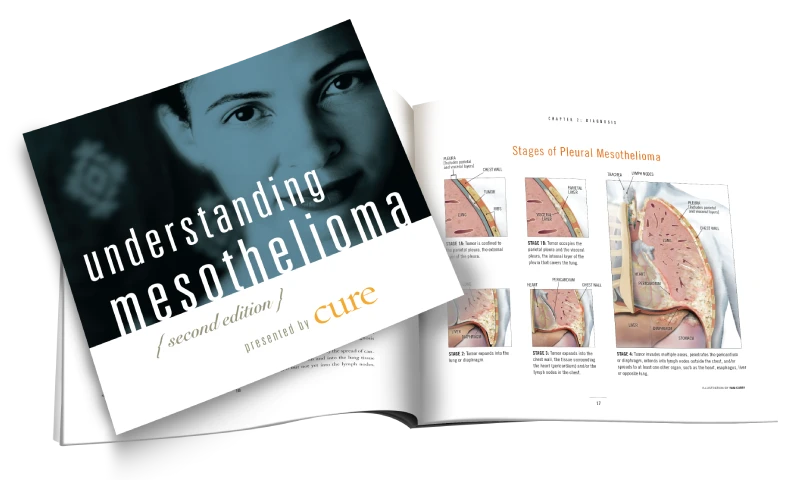Home › Mesothelioma
Mesothelioma
Last Updated:
- May 16, 2025
The disease has no known cure, though an earlier diagnosis can lead to a better prognosis. Treatments like surgery, radiation, immunotherapy, and chemotherapy can help improve survival rates, but the average life expectancy after being diagnosed with mesothelioma is 18 to 24 months. Early symptoms include chest pain, back pain, and shortness of breath.
What Is Mesothelioma?
Mesothelioma is a type of cancer in which cancer cells develop in the mesothelium, the thin layer of cells lining the body’s internal organs, including the lungs, abdomen, and heart.
In mesothelioma, cancer cells can develop in the pleura, which lines the chest cavity and covers the lungs, and the peritoneum, which lines the abdomen and covers other organs. On rare occasions, these cells can also develop in the pericardium, which is the membrane surrounding the heart, or the lining of the testicles.
If you’ve been exposed to asbestos, even if it was decades ago—you are at risk of developing mesothelioma.
Long Latency Period
The latency period for developing mesothelioma is 20 to 60 years from the date of first exposure to asbestos.
Types of Mesothelioma
Pleural Mesothelioma
develops in the lining of the lungs. It is the most common form of mesothelioma, accounting for 70-90 percent of diagnoses.
Pericardial Mesothelioma
develops in the heart's lining and is one of the rarest mesotheliomas, accounting for around 1 percent of diagnoses.
Peritoneal Mesothelioma
develops in the lining of the abdominal cavity. It is the second most common form of mesothelioma, accounting for 10-30 percent of diagnoses, and is more aggressive than other mesotheliomas, spreading quickly from the abdomen to other body parts.
Testicular Mesothelioma
develops in the lining of the testicles. It is the rarest of mesothelioma cancers, making up less than 1 percent of diagnoses, and misdiagnosis is common.
Mesothelioma Symptoms
If you suspect that you or a loved one has been exposed to asbestos in the past, it’s important to monitor for the symptoms of mesothelioma to catch the disease. Mesothelioma has a long latency period, typically taking decades for symptoms to surface. However, despite that latency period, mesothelioma is an extremely aggressive cancer once symptoms appear, and the prognosis is significantly better the sooner patients are diagnosed.
Mesothelioma has several symptoms that vary depending on the type and stage of the cancer.
Some of the common symptoms of pleural mesothelioma include:
- Fatigue
- Shortness of breath
- Dry cough
- Chest pain
- Weight loss
- Respiratory problems
- Pneumonia
Some common symptoms of peritoneal mesothelioma include:
- Abdominal pain
- Swelling or fluid in the abdomen
- Nausea
- Vomiting
- Constipation
- Loss of appetite
Some typical pericardial mesothelioma symptoms include:
- Chest pain
- Shortness of breath
- Irregular heart rhythm
- Heart murmur
Did You Know?
Symptoms of mesothelioma typically do not arise until the disease has reached later stages. When they arise, most are nonspecific in nature, including weight loss, fatigue, and night sweats.
Causes of Mesothelioma
The sole known cause of mesothelioma is asbestos exposure. The disease develops after microscopic airborne fibers of the mineral asbestos are inhaled or swallowed. When asbestos-containing products are installed, removed, or manufactured, these fibers are disturbed and released into the air. The fibers can remain airborne for a long time, increasing the likelihood of inhaling them if you’re anywhere nearby.
Mesothelioma most often results from occupational asbestos exposure. Workers at factories, industrial plants, and other worksites that made or used asbestos-containing products were exposed to significant amounts of asbestos dust daily, even if they didn’t work with the products directly. Just being around other tradespeople using asbestos-containing materials on job sites can expose workers.
Unfortunately, mesothelioma can also result from secondary exposure. For instance, spouses and children who do the laundry for their family may come into contact with asbestos on their spouse’s or dad’s clothes if he was exposed to asbestos at work.
Men More At Risk
Men are 4.6 times more likely to be diagnosed with mesothelioma than women, largely because of a historically increased exposure to asbestos at places of work.
Diagnosing Mesothelioma
Because mesothelioma symptoms are often nonspecific, a diagnosis requires a combination of physical, radiological, and pathological examinations. It will also involve obtaining an accurate patient history, including potential asbestos exposure at the workplace or elsewhere.
There are a variety of tests that examine the inside of the chest and abdomen which physicians can use to detect and diagnose mesothelioma, including the following:
- Physical exam and history: an exam of the body to check general signs of health, including checking for signs of disease and discussing the patient’s health history, exposure to asbestos, and past illnesses
- Chest X-ray: an X-ray of the organs and bones inside the chest
- Complete blood count, or CBC: a procedure in which a blood sample is checked for blood cell and platelet count, hemoglobin count, and how much of the sample consists of red blood cells
- Sedimentation rate: a procedure to determine the rate at which the red blood cells settle to the bottom of a test tube
- Biopsy: the removal of cells or tissues from the pleura or peritoneum so a pathologist can view them under a microscope to check for signs of cancer
- Bronchoscopy: a procedure to look for abnormalities inside the trachea and large airways in the lungs, potentially involving the taking of tissue samples to check for signs of cancer under a microscope
- Cytologic exam: a procedure examining cells from fluid around the lungs or abdomen under a microscope to check for anything abnormal
Rise in U.S. Cases
Reported cases of mesothelioma have continued to rise in the United States and around the world. In the U.S., between 2,500 to 3,000 people are diagnosed with mesothelioma every year.
Stages of Mesothelioma
After mesothelioma is diagnosed, the next step is to determine the stage of the disease. Testing determines whether cancer cells have spread to other parts of the body. The mesothelioma staging system used by most major cancer centers in the United States is the TNM staging system developed by the American Joint Committee on Cancer. There are four possible stages of pleural mesothelioma based on this system.
Stage 1
Stage 2
Stage 3
In stage 3 mesothelioma, the cancer has spread to any of the following areas:
- The chest wall
- The mediastinum, or the center section of the thoracic cavity
- The heart
- Beyond the diaphragm
- The peritoneum
- Lymph nodes on the other side of the chest or outside the chest
The malignancy has spread into the fatty part of the mediastinum behind the breastbone and between the lungs or into the lymph nodes within the thorax.
Stage 4
Mesothelioma Prognosis
Multiple factors affect a patient’s prognosis and treatment options. The main factor is the type of mesothelioma cancer cells and how they look under a microscope. The types of cells are as follows:
- Epithelioid Cells are the most common and treatable type of mesothelioma cells, making up about 60 percent of cases. The prognosis with these cells is generally better than the other two types.
- Sarcomatoid Cells are the least common but most aggressive form of mesothelioma, making up approximately 10 to 20 percent of cases. These cells are resistant to treatment, making the prognosis for this type of mesothelioma very poor.
- Biphasic Cells involve a mix of epithelial and sarcomatoid cells. These are the second most common types of mesothelioma cells, occurring in 20 to 40 percent of cases. The prognosis and response to treatment depend on the ratio of these cells. More epithelioid cells typically result in a better prognosis, as sarcomatoid cells are resistant to therapy.
A mesothelioma patient’s prognosis can also depend on the following factors:
- The stage of the cancer
- The size of the tumor
- Whether the tumor can be removed completely by surgery
- The amount of fluid in the chest or abdomen
- The patient’s age and general health, including lung and heart health
- Whether the cancer has just been diagnosed or has recurred
Did You Know?
Determining the cell structure of a patient’s mesothelioma is one of the first steps in establishing a plan of action for the treatment of the disease.
Mesothelioma Treatment Options
While there is no cure for mesothelioma, advancements in oncology treatment have increased the life expectancy and quality of life for people diagnosed early. Meanwhile, new types of treatment are being tested in clinical trials.
Treatment aims to reduce the size and growth rate. The three main types of standard mesothelioma treatment include the following:
- Surgery – Surgeries to remove tumors include wide local excision, pleurectomy and decortication, extrapleural pneumonectomy, and pleurodesis.
- Radiation therapy – This cancer treatment uses high-energy X-rays or other types of radiation to kill cancer cells or keep them from growing.
- Chemotherapy – This cancer treatment uses drugs to stop the growth of cancer cells, either by killing them or stopping them from dividing.
- Immunotherapy – Immunotherapy includes a group of emerging treatments currently only available through clinical trials. This method uses a patient’s own immune system to fight mesothelioma.
The sooner mesothelioma is diagnosed, the better. Earlier stages of mesothelioma may have more treatment options.
- Our Sponsor, Baron & Budd, P.C.
Compensation for Mesothelioma Victims
When someone is diagnosed with mesothelioma, they may have several options for pursuing compensation. Depending on how the patient was exposed, different types of claims are available, including:
- Personal injury claims
- Wrongful death claims
- Asbestos trust funds
- VA compensation for veterans
- Out-of-court mesothelioma settlements
Compensation is important because mounting expenses can potentially drive you and your family into bankruptcy. You can hold the parties responsible for your illness accountable for the financial costs, pain, and suffering resulting from your illness.
Free Mesothelioma Book
Understanding Mesothelioma, 2nd Edition is a must-read for anyone affected by mesothelioma. This FREE book was created to educate mesothelioma patients and their families about the cancer. It is a 10-chapter, 81-page book that provides an overview of mesothelioma, including its causes, diagnosis, and new treatment options. Order your copy today!

Order Your Free Mesothelioma Book

Content Reviewed by
Todd Kale
Todd Kale meets with mesothelioma patients and their families across Louisiana to investigate their asbestos exposure, providing compassionate support and guidance during a difficult time.
